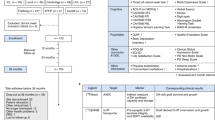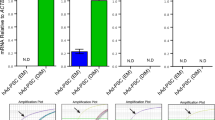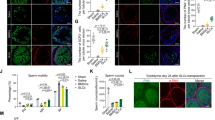Abstract
Neural tissue transplantation has become an alternative treatment for Parkinson's disease (PD)1,2 and other neurodegenerative disorders. The clinical use of neural grafts as a source of dopamine for Parkinson's disease patients, although beneficial, is associated with logistical and ethical issues. Thus, alternative graft sources have been explored including polymer-encapsulated cells and nonneural cells (that is, adrenal chromaffin cells) or genetically modified cells that secrete dopamine and/or trophic factors3–5. Although progress has been made, no current alternative graft source has ideal characteristics for transplantation. Emerging evidence suggests the importance of trophic factors in enhancing survival and regeneration of intrinsic dopa-minergic neurons6. It would be desirable to transplant cells that are readily available, immunologically accepted by the central nervous system and capable of producing dopamine and/or trophic factors. Sertoli cells have been shown to secrete CD-95 liqand7 and regulatory proteins8, as well as trophic, tropic, and immunosuppressive factors9,10 that provide the testis, in part, with its “immunoprivileged” status. The present study demonstrated that transplantation of rat testis-derived Sertoli cells into adult rat brains ameliorated behavioral deficits in rats with 6-hydroxydopamine-induced hemiparkinsonism. This was associated with enhanced tyrosine hydroxylase (TH) immunoreactivity in the striatum in the area around the transplanted Sertoli cells. Furthermore, in vitro experiments demonstrated enhanced dopaminergic neuronal survival and outgrowth when embryonic neurons were cultured with medium in which rat Sertoli cells had been grown. Transplantation of Sertoli cells may provide a useful alternative treatment for PD and other neurodegenerative disorders.
This is a preview of subscription content, access via your institution
Access options
Subscribe to this journal
Receive 12 print issues and online access
$209.00 per year
only $17.42 per issue
Buy this article
- Purchase on Springer Link
- Instant access to full article PDF
Prices may be subject to local taxes which are calculated during checkout
Similar content being viewed by others
References
Björklund, A. et al. Cross-species neural grafting in a rat model of Parkinson's disease. Nature 298, 652 –654 (1982).
Emerich, D.F. et al. Behavioral effects of neural transplantation. Cell Transplant. 1, 401–127 (1992).
Lindvall, O. et al. Transplantation in Parkinson's disease: Two cases of adrenal medullary grafts to the putamen. Ann. Neurol. 22, 457–468 (1987).
Emerich, D.F. et al. A novel approach to neural transplantation in Parkinson's disease: Use of polymer encapsulated cell therapy. Neurosci. Behav. Rev. 16, 437–447 (1992).
Kawaja, M.D. & Gage, F.H. Morphological and neurochemical features of cultured primary skin fibroblasts of Fischer 344 rats following striatal implantation. J. Comp. Neurol. 317, 102–116 (1992).
Takayama, H. et al. Basic fibroblast growth factor increases dopaminergic graft survival and function in a rat model of Parkinson's disease. Nature Med. 1, 53–58 (1995).
Sanberg, P.R. et al. The testis-derived cultured Sertoli cell as a natural Fas-L secreting cell for immunosuppressive cellular therapy. Cell Transplant. 6, 191–193 (1997).
Skinner, M.K. Secretion of growth factors and other regulatory factors. in: The Sertoli Cell. (eds. Russell, L.D. & Griswold, M.D.) 237–248 (Cache River Press, Clearwater, FL, 1993).
Selawry, H.P. & Cameron, D.F. Sertoli cell-enriched fractions in a successful islet cell transplantation. Cell Transplant. 2, 123–129 (1993).
Sanberg, P.R., Borlongan, C.V., Saporta, S. & Cameron, D.F., Sertoli cells survive and provide localized immunoprotection for xenografts in rat brain. Nature Biotechnol. 14, 1692–1695 (1996).
Borlongan, C.V. & Sanberg, P.R. Elevated body swing test: A new behavioral parameter for rats with 6-hydroxydopamine-induced hemiparkinsonism. J. Neurosci. 15, 5372–5378 (1995).
Hudson, J.L. et al. Correlation of apomorphine- and amphetamine-induced turning with nigrostriatal dopamine content in unilateral 6-hydroxydopamine lesioned rats. Brain Res. 626, 167–174 (1993).
Appel, S.H. & Smith, G. Can neurotrophic factors prevent or reverse motor neuron injury in amyotrophic lateral sclerosis? Exp. Neural. 124, 100–102 (1993).
Lin, L.H. et al. GDNF: A glial cell line-derived neurotrophic factor for midbrain dopaminergic neurons. Science 246, 1023–1025 (1993).
Zurn, A.D. et al. Glial cell-line derived neurotrophic factor (GDNF), a new neurotrophic factor for motoneurones. NeuroReport 6, 113–118 (1994).
Bowenkamp, K.E. et al. Glial cell line-derived neurotrophic factor supports survival of injured midbrain dopaminergic neurons. J. Comp. Neurol. 355, 479–489 (1995).
Choi-Lundberg, D.L. & Bohn, M.C. Ontogeny and distribution of glial cell line derived neurotrophic factor (GDNF) mRNA in rat. Dev. Brain Res. 85, 80–88 (1995).
Bitgood, J., Shen, L. & McMahon, A.P. Sertoli cell signaling by Desert hedgehog regulates the male germline. Curr. Biol. 6, 298–304 (1996).
Miao, N., Wang, M., Woolf, T.M. & Pang, K. A neurotrophic activity of sonic hedgehog promotes the survival of dopaminergic neurons. Cell Transplant. 5S-2, 17 (1996).
Othberg, A. et al. Specific effects of platelet derived growth factor (PDGF) on embryonic rat and human dopaminergic neurons in vitro. Exp. Brain Res. 105, 111–122 (1995).
Author information
Authors and Affiliations
Rights and permissions
About this article
Cite this article
Sanberg, P., Borlongan, C., Othberg, A. et al. Testis-derived Sertoli cells have a trophic effect on dopamine neurons and alleviate hemiparkinsonism in rats. Nat Med 3, 1129–1132 (1997). https://doi.org/10.1038/nm1097-1129
Received:
Accepted:
Issue Date:
DOI: https://doi.org/10.1038/nm1097-1129
This article is cited by
-
Effect of Sertoli Cell Transplantation on Reducing Neuroinflammation-Induced Necroptosis and Improving Motor Coordination in the Rat Model of Cerebellar Ataxia Induced by 3-Acetylpyridine
Journal of Molecular Neuroscience (2020)
-
Sertoli Cells Avert Neuroinflammation-Induced Cell Death and Improve Motor Function and Striatal Atrophy in Rat Model of Huntington Disease
Journal of Molecular Neuroscience (2018)
-
Comparative Effect of Human Platelet Derivatives on Proliferation and Osteogenic Differentiation of Menstrual Blood-Derived Stem Cells
Molecular Biotechnology (2014)
-
Therapeutic targets and limits of minocycline neuroprotection in experimental ischemic stroke
BMC Neuroscience (2009)
-
The neuroprotective effect of dental pulp cells in models of Alzheimer’s and Parkinson’s disease
Journal of Neural Transmission (2009)



